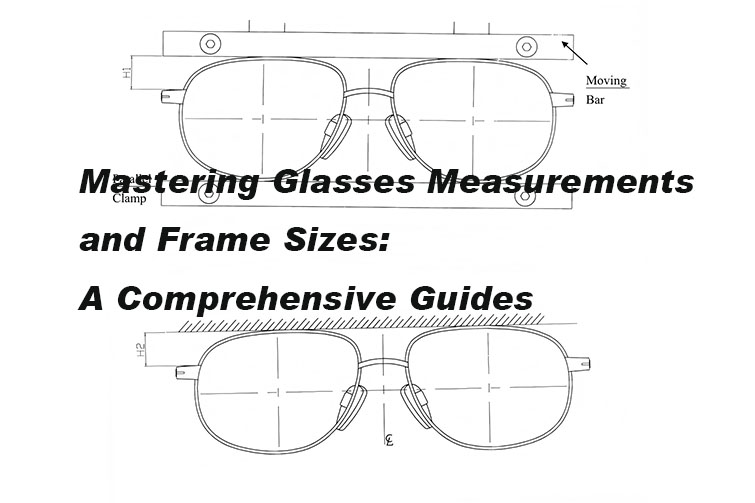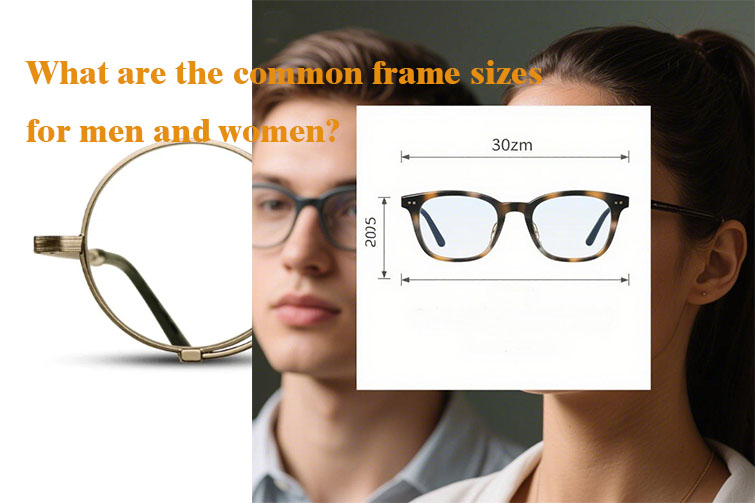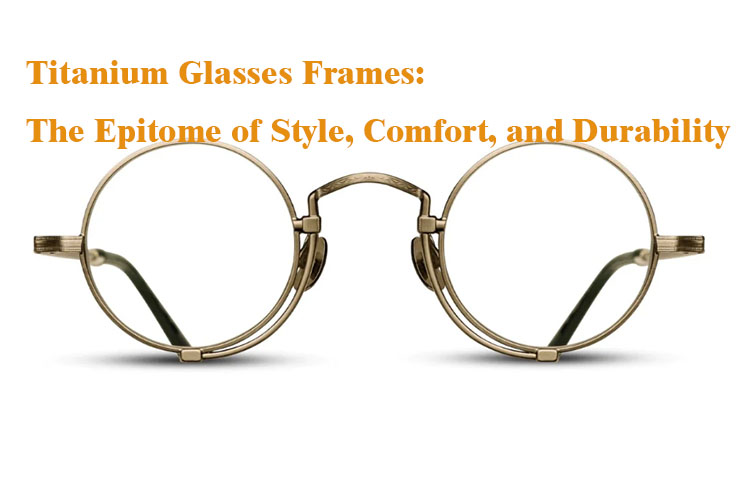

Mastering Glasses Measurements and Frame Sizes: A Comprehensive Guide
Decoding Key Elements of Glasses Measurements
Eye Rim Measurements: The Foundation of a Good Fit
1. Width (Size A) Measurement
1. For full - rim frames, measuring the width (Size A) requires precision. First, measure the inner gap between the two sides of the rim. However, this is not the final measurement. Since full - rim frames have a groove to hold the lenses, you need to account for the groove depth. For instance, if the inner gap is 45mm and the groove depth on each side is 1mm, the actual Size A measurement would be 45 + 2(1)=47mm.
2. In half - rim or rimless frames, the approach is different. Here, the width is often measured from the outermost points of the lens - holding structure, as there is no full - encircling rim. This method ensures that the lenses, which are usually held in place by other means like screws or clips, fit securely.
2. Depth (Size B) Measurement
1. Similar to the width, the depth (Size B) of the eye rim also varies based on the frame type. In full - rim frames, measure the vertical distance from the top to the bottom of the inner rim space, again adjusting for any grooves. For example, if the inner vertical distance is 30mm and the groove depth at the top and bottom is 0.5mm each, the Size B measurement would be 30+2(0.5) = 31mm.
2. Half - rim and rimless frames may have their own set of rules. In some half - rim designs, the depth might be measured from the top of the lens - holding part to the bottom edge where the lens is secured. These measurements are vital as they determine how well the lenses will be held within the frame, ensuring a proper fit on the face.
Bridge Size Measurement: Comfort on the Nose
1. Full - Rim Frame Bridge Measurement
1. The bridge size (DBL) in full - rim frames is measured as the horizontal distance between the inner edges of the two lenses where they meet at the bridge. This measurement is crucial for ensuring that the glasses sit comfortably on the nose. If the bridge size is too wide, the glasses may slide down the nose, and if it's too narrow, it can cause pressure points. For example, for a full - rim frame with a traditional design, a DBL of 16mm might be suitable for an average - sized nose.
2. Half - Rim and Rimless Frame Bridge Measurement
1. In half - rim and rimless frames, the bridge measurement can be more complex. Since the frame structure is different, the DBL may be measured from the center of the lens - mounting points on the bridge. The lack of a full - rim around the lenses means that the bridge has to bear more of the weight distribution, so an accurate measurement is even more important. A well - measured bridge in these frame types can prevent the glasses from feeling unbalanced on the face.
Temple Measurements: Ensuring Stability and Comfort
1. Length Measurement
1. Measuring the temple length is essential for a secure fit. The length of the whole temple, from the hinge point to the tip, should be appropriate for the wearer's head size. For adults, a temple length of 140 - 145mm is common. However, for those with larger or smaller heads, adjustments may be needed. A longer temple length, say 150mm, might be suitable for someone with a larger head circumference, while a shorter length like 135mm could be better for a smaller head.
2. Diameter, Thickness, and Width Measurements
1. The diameter, thickness, and width of the temple also contribute to the fit. A thicker temple may provide more stability but could be heavier, while a thinner temple might be lighter but less sturdy. The width of the temple at the hinge and at the tip can affect how the temple sits on the ear. For example, a wider temple tip can distribute the weight of the glasses more evenly on the ear, reducing discomfort.
3. Hinge and Temple Tip Angle Measurements
1. The position of the hinge and the angle of the temple tip are often overlooked but are very important. The hinge should be placed in a way that allows the temples to open and close smoothly and sit comfortably on the sides of the head. The temple tip angle, which is the angle at which the tip of the temple curves towards the ear, should be adjusted to fit the natural shape of the ear. A well - angled temple tip can prevent the glasses from slipping off the ears.
Understanding Common Frame Sizes and Their Significance
Standard Size Ranges: A Guide for Fit
1. Adult Frame Sizes
1. Eye Rim Width: Adult frame eye rim widths typically fall within two main ranges. One range is from 33 - 59mm for frames with odd - numbered sizes, and the other is 34 - 60mm for even - numbered sizes. These ranges are designed to accommodate different face widths. For example, a person with a narrow face might find a frame with an eye rim width of 36mm more suitable, while someone with a wider face could opt for a 54mm width.
2. Nose Bridge Size: The nose bridge size for adults commonly ranges from 16 - 18mm. This range ensures that the glasses can be comfortably supported on the nose without causing discomfort. A 16mm bridge might be suitable for someone with a narrow nose, while an 18mm bridge could be better for a wider - nosed individual.
3. Temple Length: As mentioned earlier, adult temple lengths are often 140 - 145mm. This length is designed to fit the average adult head circumference, providing a secure and comfortable fit.
2. Children's Frame Sizes
1. Eye Rim Width: Children's frames usually have an eye rim width in the range of 40 - 48mm. Since children's faces are smaller than adults', these smaller sizes are more appropriate. For example, a young child might need a frame with a 42mm eye rim width.
2. Nose Bridge Size: The nose bridge size for children is commonly 15 or 16mm. This is because children's noses are smaller and more delicate, and a smaller bridge size can provide a better fit without causing pressure.
3. Temple Length: Temple lengths for children are typically 120 - 135mm, which is shorter than adult temple lengths to fit the smaller head sizes of children.
Influence on Fit: The Consequences of Incorrect Sizing
1. Discomfort
1. A frame that is too large can cause discomfort in several ways. The glasses may slide down the nose, constantly requiring adjustment. The temples may be too long, causing them to dig into the sides of the head or not fit properly behind the ears. On the other hand, a frame that is too small can also be uncomfortable. The bridge may put excessive pressure on the nose, and the temples may be too tight, causing headaches.
2. Vision Problems
1. Incorrect frame sizing can also affect vision. If the frame is not sitting correctly on the face, the lenses may not be in the proper position in front of the eyes. This can lead to distorted vision, eye strain, and even contribute to headaches. For example, if the eye rim width is too wide, the lenses may be positioned too far apart from the eyes, misaligning the optical axis and causing visual problems.
Practical Tips for Choosing the Right Frame Size
Consider Face Shape: Enhancing Facial Features
1. Round Faces
1. For those with round faces, square or rectangular frames can be a great choice. The angular shape of these frames provides a contrast to the roundness of the face, helping to create a more balanced look. The straight lines of a square frame can add definition to a round face, making the face appear more structured.
2. Oval Faces
1. Oval faces are considered the most versatile when it comes to frame selection. Oval - faced individuals can suit a variety of frame styles, from classic round frames to modern geometric designs. This is because the oval face shape is well - proportioned, and different frame shapes can enhance its natural beauty.
Match with Other Factors: Color, Material, and Lifestyle
1. Color Compatibility
1. The color of the frame should complement the wearer's skin tone and hair color. For example, people with warm skin tones may look better in frames with warm colors like browns, golds, or tortoiseshell. Those with cool skin tones might prefer frames in cool colors such as silver, blue, or black. The frame color can also be used to make a fashion statement. A bold - colored frame can add a pop of color to an outfit, while a neutral - colored frame can be more versatile and suitable for everyday wear.
2. Material Considerations
1. The material of the frame affects several aspects. Titanium frames are lightweight and durable, making them an excellent choice for those with active lifestyles. They are also hypoallergenic, which is beneficial for people with sensitive skin. Acetate frames, on the other hand, come in a wide variety of colors and patterns and can be more flexible. However, they may be heavier than titanium. When choosing a frame material, it's important to consider factors such as durability, weight, and any potential allergic reactions.
Conclusion
Mastering glasses measurements and frame sizes is essential for anyone in the market for new eyewear. By understanding the key elements of measurements, common frame size ranges, and how to choose the right size based on face shape and other factors, you can ensure a comfortable, stylish, and functional pair of glasses. Whether you're a consumer looking for the perfect fit or a professional in the eyewear industry, these insights will help you make informed decisions.









